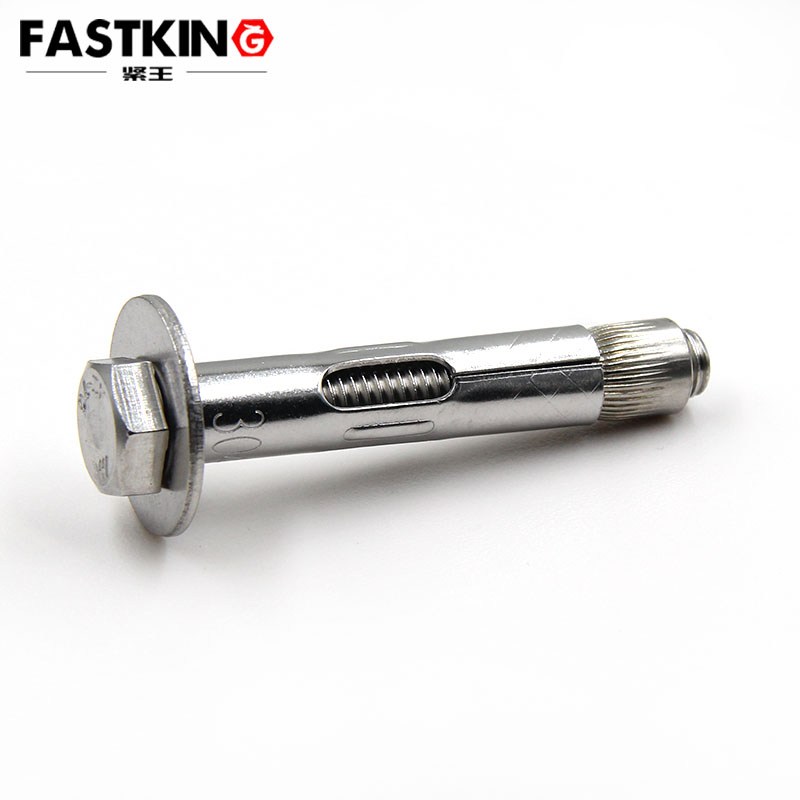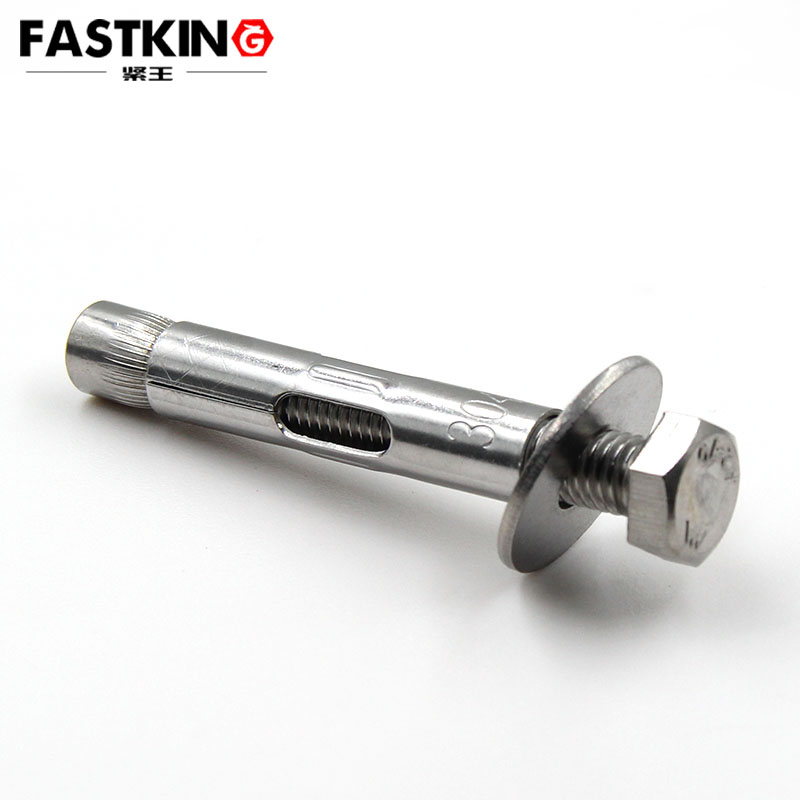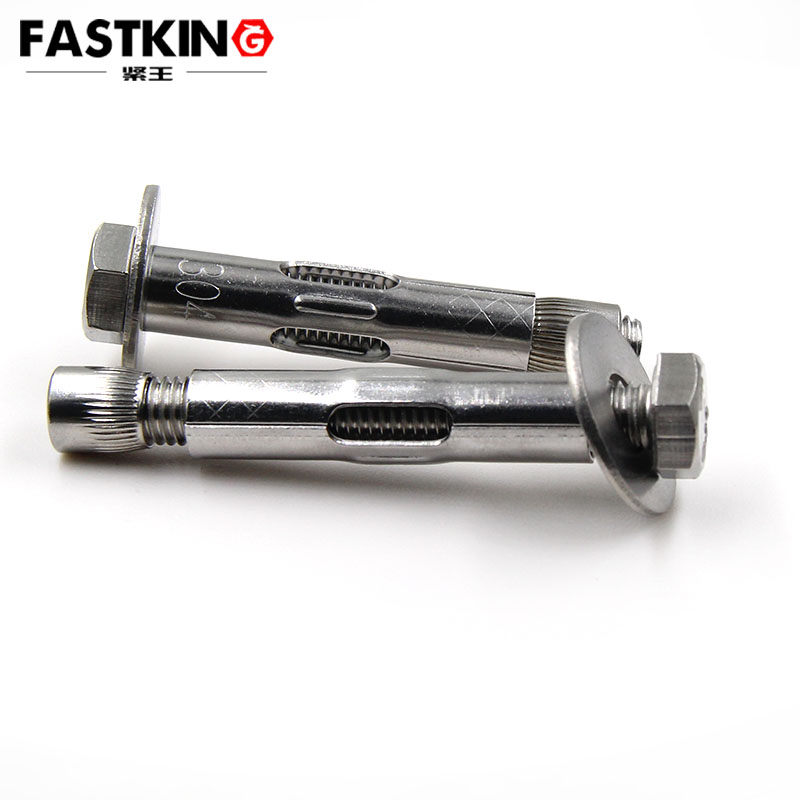

From the perspective of working principle and structural design, the core of the fixed expansion screw for the bracket bottom lies in "expansion force locking". Such screws usually consist of four parts: a screw rod, an expansion tube, a washer, and a nut, and some models are also equipped with elastic washers or anti-retreat rings. Their working logic is clear and efficient: during installation, first drill a hole matching the diameter of the expansion tube on the base surface (such as a concrete floor), insert the expansion tube and the screw rod into the hole together, and then tighten the nut. During the nut tightening process, the screw rod will be pulled upward, forcing the tail of the expansion tube to expand and deform in the hole, tightly squeezing the hole wall to form strong friction and biting force, and finally "locking" the screw and the base surface into one body. The ingenuity of this design is that the expansion force increases synchronously with the degree of nut tightening, and the fitting surface between the expansion tube and the hole wall is distributed in a ring shape, which can evenly disperse the load transmitted by the bracket, avoiding cracks on the base surface or loosening of the screw due to excessive local stress.
The core advantages of the fixed expansion screw for the bracket bottom are concentrated in three dimensions: "strong load-bearing capacity", "wide adaptability", and "easy installation". Firstly, the "strong load-bearing capacity" performance: unlike ordinary screws that only rely on thread engagement for fixation, expansion screws can withstand greater axial tensile force and radial shear force through the mechanical locking between the expansion tube and the hole wall. Taking the common M12 metal expansion screw as an example, on a C30 concrete base, its axial tensile bearing capacity can reach more than 15kN, and the radial shear bearing capacity exceeds 8kN, which is sufficient to support the long-term load of medium and heavy equipment such as photovoltaic brackets and air conditioner outdoor unit brackets. Secondly, the "wide adaptability" feature: in terms of base surface materials, it can be adapted to various hard bases such as concrete, solid brick walls, marble, and granite, and only needs to adjust the drilling depth and hole diameter according to the material hardness; in terms of bracket types, whether it is an angle steel bracket, an aluminum alloy bracket, or a channel steel bracket, it can achieve a tight connection through supporting washers and nuts without additional processing of adaptive components. Finally, the "easy installation" advantage: the installation process does not require complex equipment, only conventional tools such as electric drills and wrenches, and has low technical requirements for installers. As long as the drilling depth matches the length of the expansion tube and the hole diameter error is controlled within ±0.5mm, reliable fixation can be completed, greatly reducing the construction difficulty and time cost.
In practical application scenarios, fixed expansion screws for the bracket bottom can be found in various fields, and show differentiated application characteristics according to scenario requirements. In the field of photovoltaic power plants, the bottom fixation of ground photovoltaic brackets is a key link - the brackets need to bear the weight of solar panels and at the same time resist the impact of harsh weather such as strong winds and heavy snow. At this time, stainless steel expansion screws (such as models 304 or 316) are selected. Their corrosion resistance can cope with environmental impacts such as outdoor humidity and temperature changes, ensuring that the brackets do not rust or loosen during a service life of more than 25 years. During installation, a spring washer is usually installed between the expansion screw and the bracket base to further enhance the anti-vibration capacity and prevent the nut from loosening due to long-term wind.
In the field of construction and decoration, the bottom fixation of air conditioner outdoor unit brackets and ventilation duct brackets also relies on such expansion screws. Taking the air conditioner outdoor unit bracket as an example, since the outdoor unit will generate continuous vibration during operation, if it is not fixed firmly, it is easy to cause noise or even fall risks. Therefore, expansion screws with anti-retreat structures are selected. The anti-retreat ring on the screw rod can clamp the expansion tube after the nut is tightened, preventing the screw rod from retreating due to vibration; at the same time, it is matched with a nitrile rubber washer, which can not only buffer vibration but also prevent rainwater from seeping into the gap between the screw and the bracket, delaying rusting.
In the field of industrial equipment installation, the bottom fixation of machine tool brackets and assembly line brackets has higher requirements for precision. In such scenarios, "internal expansion screws" (also known as "countersunk expansion screws") are usually selected. Their expansion tubes are hidden in the base holes, and after installation, the head of the screw rod can be flush with the bottom of the bracket, avoiding the protruding parts affecting the positioning accuracy of the equipment. In addition, a torque wrench is used to strictly control the tightening torque to ensure that the fastening force of each expansion screw is uniform, preventing the bracket from tilting due to uneven force.
To give full play to the performance of the fixed expansion screw for the bracket bottom, correct installation methods and selection strategies are crucial. Before installation, it is necessary to conduct a base surface inspection: if the base surface is concrete, it is necessary to confirm that its strength grade is not lower than C20 to avoid the expansion tube being unable to expand effectively due to loose base; if it is a brick wall, it is necessary to select a solid brick area and avoid hollow bricks or brick joints to prevent the hole wall from being unable to provide sufficient support force after drilling. The drilling link needs to pay attention to "matching": the hole diameter must be consistent with the outer diameter of the expansion tube (for example, an M10 expansion screw corresponds to a 12mm hole diameter), and the drilling depth must be 5-10mm more than the length of the expansion tube to reserve a space for dust accommodation and avoid dust affecting the deformation of the expansion tube.
When tightening the nut, the "progressive" principle must be followed: first manually screw the nut until the expansion tube initially contacts the hole wall, then use a wrench to tighten it in 2-3 times, and pause for 10-15 seconds after each tightening to allow the expansion tube to fully deform and fit the hole wall, avoiding the expansion tube breaking or the base surface cracking due to excessive force at one time. After installation, it is necessary to verify the fastening effect through a "pull-out test" - for brackets carrying important equipment, a tension meter should be used to detect the actual axial tensile bearing capacity of the expansion screw to ensure that it is not less than 90% of the design value.
In terms of selection, three factors need to be comprehensively considered: first, the load requirement. According to the total weight of the bracket and the upper equipment, combined with the base surface material, the specification of the required expansion screw is calculated through mechanical formulas (for example, for a photovoltaic bracket bearing 100kg, an M8 expansion screw can be selected on a C30 concrete base, and each bracket is equipped with at least 4 screws); second, the environmental conditions. For outdoor or humid environments, stainless steel materials are preferred; for acid-base environments, 316 stainless steel or Teflon-coated expansion screws are required; for dry indoor environments, galvanized carbon steel models can be selected to control costs; third, the installation space. If the space at the bottom of the bracket is narrow, "short expansion screws" can be selected. Their expansion tubes are shortened but the expansion force remains unchanged, which is suitable for compact installation scenarios.
As the "invisible cornerstone" of the support structure, although the fixed expansion screw for the bracket bottom is small in size, it undertakes the important mission of ensuring the safety of people and equipment. Its "expansion fastening" principle breaks the limitation of traditional screws relying on thread engagement, and adapts to diverse base surfaces and load requirements with a more reliable mechanical locking method. In the future, with the development of fields such as photovoltaics, new energy, and intelligent construction, the demand for bracket expansion screws will become more refined - new products such as "micro expansion screws" suitable for lightweight partition walls and "intelligent expansion screws" with real-time fastening force monitoring functions will continue to emerge, continuously providing safer and more efficient fixing solutions for various support structures.



